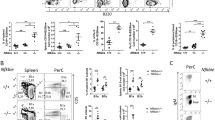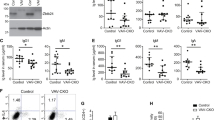Abstract
Mice deficient in the Ung uracil-DNA glycosylase have an increased level of uracil in their genome, consistent with a major role of Ung counteracting U : A base pairs arising by misincorporation of dUMP during DNA replication. A complementary uracil-excising activity apparently acts on premutagenic U : G lesions resulting from deamination of cytosine throughout the genome. However, Ung specifically processes U : G lesions targeted to immunoglobulin variable (V) genes during somatic hypermutation and class-switch recombination. Gene-targeted Ung−/− null mice remained tumour-free and showed no overt pathological phenotype up to ∼12 months of age. We have monitored a large cohort of ageing Ung−/− mice and, beyond 18 months of age, they had a higher morbidity than Ung+/+ controls. Post-mortem analyses revealed pathological changes in lymphoid organs, abnormal lymphoproliferation, and a greatly increased incidence of B-cell lymphomas in older Ung-deficient mice. These are the first data reporting the development of spontaneous malignancies in mice due to deficiency in a DNA glycosylase. Furthermore, they support a specific role for Ung in the immune system, with lymphomagenesis being related to perturbed processing of antibody genes in germinal centre B cells.
This is a preview of subscription content, access via your institution
Access options
Subscribe to this journal
Receive 50 print issues and online access
$259.00 per year
only $5.18 per issue
Buy this article
- Purchase on SpringerLink
- Instant access to full article PDF
Prices may be subject to local taxes which are calculated during checkout




Similar content being viewed by others
References
Al-Tasaan N, Chmiel NH, Maynard J, Fleming N, Livingston AL, Williams GT, Hodges AK, Davies DR, David SS, Sampson JR and Cheadle JP . (2002). Nat. Genet., 30, 227–232.
Aravind L and Koonin EV . (2000). Genome Biol., 1, 1–8.
Blount BC, Mack MM, Wehr CM, MacGregor JT, Hiatt RA, Wang G, Wickramasinghe SN, Everson RB and Ames BN . (1997). Proc. Natl. Acad. Sci. USA, 94, 3290–3295.
Di Noia J and Neuberger MS . (2002). Nature, 419, 43–48.
Elder RH and Dianov GL . (2002). J. Biol. Chem., 277, 50487–50490.
Elder RH, Jansen JG, Weeks RJ, Willington MA, Deans B, Watson PJ, Mynett KJ, Bailey JA, Cooper DP, Rafferty JA, Heeran MC, Wijnhoven SWP, van Zeeland AA and Margison GP . (1998). Mol. Cell. Biol., 1, 5828–5837.
Engelward BP, Weeda G, Wyatt MD, Broekhof JLM, deWit J, Donker I, Allan JM, Gold B, Hoeijmakers JHJ and Samson LD . (1997). Proc. Natl. Acad. Sci. USA, 94, 13087–13092.
Faili A, Aoufouchi S, Flatter E, Gueranger Q, Reynaud C-A and Weill J-C . (2002). Nature, 419, 944–947.
Goulian M, Bleile B and Tseng B . (1980). Proc. Natl. Acad. Sci. USA, 77, 1956–1960.
Haushalter KA, Stukenberg PT, Kirschner MW and Verdine GL . (1999). Curr. Biol., 9, 174–185.
Klungland A, Rosewell I, Hollenbach S, Larsen E, Daly G, Epe B, Seeberg E, Lindahl T and Barnes DE . (1999). Proc. Natl. Acad. Sci. USA, 96, 13300–13305.
Küppers R and Dalla-Favera R . (2001). Oncogene, 20, 5580–5594.
Kvaløy K, Nilsen H, Steinsbekk KS, Nedal A, Monterotti B, Akbari M and Krokan HE . (2001). Mutat. Res., 461, 325–338.
Lindahl T . (2000). Mutat. Res., 462, 129–135.
Martin A and Scharff MD . (2002). Proc. Natl. Acad. Sci. USA, 99, 12304–12308.
McDonald JP, Frank EG, Plosky BS, Rogozin IB, Masutani C, Hanaoka F, Woodgate R and Gearhart PJ . (2003). J. Exp Med., in press.
Millar CB, Guy J, Sansom OJ, Selfridge J, MacDougall E, Hendrich B, Keightley PD, Bishop SM, Clarke AR and Bird A . (2002). Science, 297, 403–405.
Minowa O, Arai T, Hirano M, Monden Y, Nakai S, Fukuda M, Itoh M, Takano H, Hippou Y, Aburatani H, Masumura K, Nohmi T, Nishimura S and Noda T . (2000). Proc. Natl. Acad. Sci. USA, 97, 4156–4161.
Muramatsu M, Kinoshita K, Fagarasan S, Yamada S, Shunkai Y and Honjo T . (2000). Cell, 102, 553–563.
Nilsen H, Haushalter KA, Robins P, Barnes DE, Verdine GL and Lindahl T . (2001). EMBO J., 20, 4278–4286.
Nilsen H, Rosewell I, Robins P, Skjelbred CF, Andersen SB, Slupphaug G, Daly G, Krokan HE, Lindahl T and Barnes DE . (2000). Mol. Cell, 5, 1059–1065.
Ocampo MT, Chaung W, Marenstein DR, Chan MK, Altamirano A, Basu AK, Boorstein RJ, Cunningham RP and Teebor GW . (2002). Mol. Cell. Biol., 22, 6111–6121.
Otterlei M, Warbrick E, Nagelhus TA, Haug T, Slupphaug G, Akbari M, Aas PA, Steinsbekk K, Bakke O and Krokan HE . (1999). EMBO J., 18, 3834–3844.
Pasqualucci L, Neumeister P, Goossens T, Nanjangud G, Chaganti RSK, Küppers R and Dalla-Favera R . (2001). Nature, 412, 341–346.
Peters A and Storb U . (1996). Immunity, 4, 57–65.
Petersen-Mahrt SK, Harris RS and Neuberger MS . (2002). Nature, 41, 99–104.
Rada C, Williams GT, Nilsen H, Barnes DE, Lindahl T and Neuberger MS . (2002). Curr. Biol., 12, 1748–1755.
Revy P, Muto T, Levy Y, Geissman F, Plebani A, Sanai O, Catalan N, Forveille M, Duforque-Lagelouse R, Gennery A, Tezcan I, Ersoy F, Kayserilli H, Ugazio AG, Brousse N, Muramatsu M, Notarangelo LD, Kinoshita K, Honjo T, Fischer A and Durandy A . (2000). Cell, 102, 565–575.
Sakumi K, Tominaga Y, Furuichi M, Xu P, Tsuzuki T, Sekiguchi M and Nakabeppu Y . (2003). Cancer Res., 63, 902–905.
Schärer OD and Jiricny J . (2001). Bioessays, 23, 270–281.
Sieber OM, Lipton L, Crabtree M, Heinimann K, Fidalgo P, Phillips RKS, Bisgaard M-L, Orntoft TF, Aaltonen LA, Hodgson SV, Thomas HJW and Tomlinson IPM . (2003). N. Engl. J. Med., 348, 791–799.
Stevenson FK, Sahota SS, Ottensmeier CH, Zhu D, Forconi F and Hamblin TJ . (2001). Adv. Cancer Res., 83, 81–116.
Takao M, Kanno S, Shiromoto T, Hasegawa R, Ide H, Ikeda S, Sarker AH, Seki S, Xing JZ, Le XC, Weinfeld M, Kobayashi K, Miyazaki J, Muijtjens M, Hoeijmakers JHJ, van der Horst G and Yasui A . (2002). EMBO J., 21, 3486–3493.
Verri A, Mazzarello P, Biamonti G, Spadari S and Focher F . (1990). Nucleic Acids Res., 18, 5775–5780.
Wong E, Yang K, Kuraguchi M, Werling U, Avdievich E, Fan K, Fazzari M, Jin B, Brown AMC, Lipkin M and Edelmann W . (2002). Proc. Natl. Acad. Sci. USA, 99, 14937–14942.
Wright BE, Reimers JM, Schmidt KH and Reschke DK . (2002). Cancer Res., 62, 5641–5644.
Acknowledgements
We thank Ashfaq Gilkar and Marokh Nohdani for histopathology, Tania Jones for sister chromatid exchange analyses, Michael Bradburn for help with statistical analysis, and Cheryl Young for technical assistance. This work was supported by Cancer Research UK. H Nilsen was the recipient of an EC Marie Curie Fellowship.
Author information
Authors and Affiliations
Corresponding author
Rights and permissions
About this article
Cite this article
Nilsen, H., Stamp, G., Andersen, S. et al. Gene-targeted mice lacking the Ung uracil-DNA glycosylase develop B-cell lymphomas. Oncogene 22, 5381–5386 (2003). https://doi.org/10.1038/sj.onc.1206860
Received:
Revised:
Accepted:
Published:
Issue Date:
DOI: https://doi.org/10.1038/sj.onc.1206860
Keywords
This article is cited by
-
Fam72a enforces error-prone DNA repair during antibody diversification
Nature (2021)
-
HDACi mediate UNG2 depletion, dysregulated genomic uracil and altered expression of oncoproteins and tumor suppressors in B- and T-cell lines
Journal of Translational Medicine (2020)
-
Tet2 loss leads to hypermutagenicity in haematopoietic stem/progenitor cells
Nature Communications (2017)
-
The Hyper IgM Syndromes
Clinical Reviews in Allergy & Immunology (2014)
-
Uracil-DNA glycosylase (UNG) rs246079 G/A polymorphism is associated with decreased risk of esophageal cancer in a Chinese population
Medical Oncology (2014)



